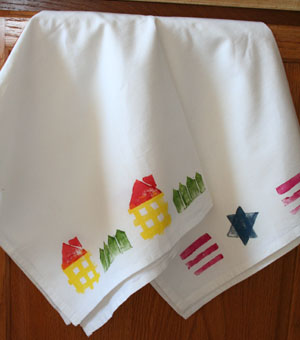
Happy Halloween, Everybody!
This will be my last post for Crafty Daisies for a while, however you can still follow my crafting adventures on my other blog craftevolution.
The Crafty Daisies Book Club will continue on craftevolution. The next book is Sew Everything Workshop by Diana Rupp and we’ll meet on Wednesday, December 3rd. See you then.
Thank you to Candace, Jen, Heather, and Joy. It’s been a great year.
Simone
]]>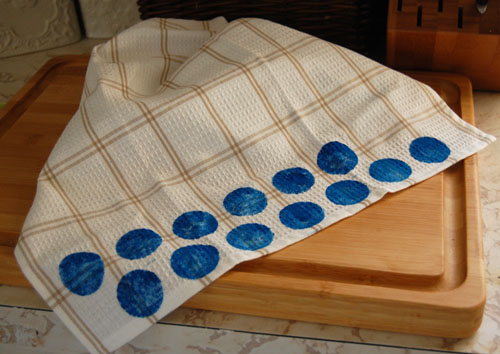
Stencil created using card stock and circle hole punch by pldover12
When I first got this book, I thought “Hmm, $19.95 (actually $11.61 from Amazon) not much to it for just seven techniques. ” I am now completely hooked on potato and leaf printing and have come to truly appreciate this little gem. This is the kind of crafting book I will pick up seeking inspiration and not necessarily instruction. It covers:
- Rubber Stamping
- Iron-on Printing
- Leaf Printing
- Stenciling
- Potato Printing
- Lino Block Printing, and
- Screen Printing
In addition it is filled with gorgeous pictures of completed projects and inspiration tablets that give you a little insight in Lotta’s design process.
Layout
The layout is calm and dominated by pictures. Instructional text is unobtrusively arranged in narrow columns accompanying the pictures.
Instructions and Projects
The instructions are very precise and clear. Seasonally appropriate, my daughter and I first delved into leaf printing. Together, we printed up a whole bunch of greeting cards, and Elizabeth made small prints for a special notebook.
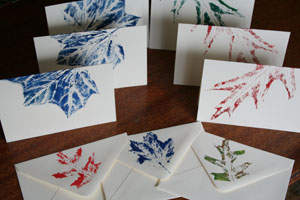
The following day I tried leaf printing with fabric paint, again with terrific results.
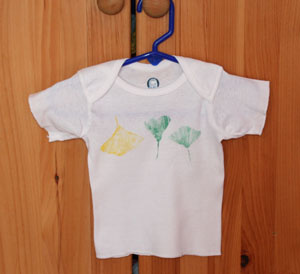
Next we started carving up potatoes with our newly acquired linoleum cutters. While I was working with putting together simple shapes. Elizabeth decided to channel Marla Olmstead. Her print did end up with a spooky potato impression.
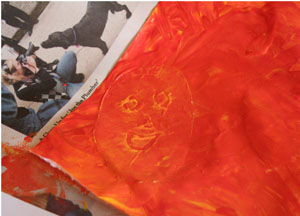
Potatoes don’t last more than a day. Really. Today I carved up a new batch and printed some onesies
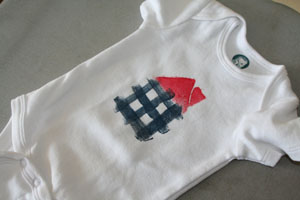
and dish towels.
I think what I like best about this “medium” is how forgiving it is (I know you are not supposed to play with food), and how it encourages you to work with very simple shapes.
Now, I’m very tempted to move on to linoleum printing–heck, I’ve got the cutters–but I think this will have to be tabled until next year. Too many projects, not enough time.
If you’d like to share your Lotta projects with your review, add them to the Crafty Daisies Book Club Flickr pool.
Change of Venue for the Next Book Club
Speaking of projects, I currently have a little giveaway of the printed tea towels on craftevolution.com where the next book club will meet. On Wednesday, December 3rd we will discuss
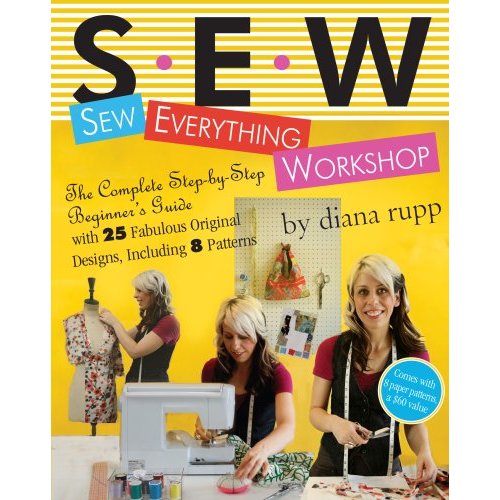
Sew Everything Workshop by Diana Rupp, ISBN-10: 0761139737, ISBN-13: 978-0761139737 and meet at craftevolution.com.
]]> 
Hamburg-Schnelsen is a sedate part of my childhood town where the butcher shop is about to celebrate its 40th anniversary and my brother’s kindergarten buddy took over the family pharmacy business. So my mother was excited to tell me about a new shop on our main street. “The woman who runs it just reminds me so much of you,” she said. And that’s how I met Alexandra in her store Das Kleine Koenigreich. The little kingdom over which she presides is filled with pretty pink and blue linens, fabrics, and other treasures she crafts in her studio in the back of her shop. Of course I had to stop by for a chat to find out how she became our new-girl-in-town.
So how did you get here?
It all started five years ago when my mother gave me a sewing machine for Christmas. I had never sewn before and started to teach myself while my toddler daughter was napping. A few months later, I was leafing through a magazine and found a pattern for a patchwork blanket. And that’s when I had this epiphany; I thought ‘I’d like to make this and sell it in my store.’ Of course there wasn’t a store, but the idea became my vision statement.
How did you make the jump from a hobby to a business?
First I sold my collection out of a stall at the Isemarkt. After a while, some stores around town picked up my products, but every delivery reminded me that my original goal was to have my own shop. My first location was in a shopping mall in downtown Hamburg. I had to close it, but was able to re-open this neighborhood shop. My present storefront works out much better for me. I’m only five minutes from my home. Whenever I have a sudden inspiration that needs to be executed immediately I can just stop by the workshop.
What inspires you?
My ideas seem to strike me out of the blue, but I also read a lot of home design magazines. My personal style tends to be cozy and Scandinavian.
What advice do you have for someone interested in starting this type of business?
You have to have realistic expectation and a certain level of financial security. For example, the closing of the first location could have had disastrous consequences if I had overextended myself. In the end, although it sounds like a cliche, you have to have a positive attitude and believe in yourself.
You can visit Alexandra at her online shop www.daskleinekoenigreich.de and take a look at the linens, pillows, bags, and musical pull toys she’s designed. Google Translate can help you with the German.
Also check out my post about alternatives to business cards to promote your crafting enterprise on craftevolution.com.
]]>
First off, Jeannie of whatthehay is sharing a tutorial on sewing your own cribsheets. She writes:
After finding out that we were pregnant with our first baby, I began the long and fun process of collecting all of the things that a new human needs to survive. First on the list? A CRIB of course! Beyond the crib (which we found at a consignment sale, along with the crib mattress) a baby needs crib sheets. Happily, Rosie has a talented grandma who was more than happy to provide her with many of the essentials of baby survival – a quilt (with strict instructions to USE it), a few totally cute outfits and 4 crib sheets.
Rosie’s Grandma is a sewing kind of lady and back when I was a kid, money was tight and so, well, she sewed. Beyond making nearly all of our clothes that weren’t hand-me-downs, she also devised a pattern for a crib sheet. Back in the day, people actually made their own sheets for their big beds, too, and she adapted this pattern from one of those patterns.
If you have a baby shower coming up, check out her crib sheet tutorial for a very useful, unique gift.
Secondly, I started another blog called craftevolution.com. It’s still in early development, but come visit to see some ideas for Halloween costumes based on basic sewing patterns and let me know what you think about the blog.
]]>
Just a reminder that the next book club will meet on October 22. We will discuss Lotta Prints by Lotta Jansdotter.

For more information, go to the original announcement. Can you guess what project I’ve been making?
]]>
Digital Scrapbook Papers are not only for scrapbooking. You can use them for a a lot of different craft projects.
Where To Get Them
- Digital Scrapbook Place: You must register to gain access to their freebies page, which offers a myriad of digital papers
- Crafts Beautiful: this British DIY site provides a ton of tutorials. Every month Crafts Beautiful introduces a new set of “backing papers.”
- Shabby Princess: Here you can find gorgeous sets of papers and embellishments. I used the 2005 holiday sampler for the projects on this post
What To Do With Them
- Print on paper and make paper beads, paper boxes (Mirkwood Designs has nice templates), envelopes, stationary

- Print on fabric using either inkjet fabric sheets or, for larger pieces of fabric, have your designs printed by Spoonflower and make appliques, key chains, napkins

- Print on shrink film (Shrinky Dinks) to make tags, earrings, charm bracelets, mobiles, drink charms

- Print on iron on transfers and decorate onesies, T-shirts, did I mention napkins?

- Create cross-stitch patterns using a tool like Artopik

What do you like to do with these papers?
P.S. Thank you to Meggie Cat who inspired this post with her collection of online tools and freeware.
]]>With a $4 tension rod and 1 yard of fabric we have already had hours of fun around our house playing with puppets and stuffed animals, having musical concerts, and using as a special door into my son’s room with a “doorbell” you have to ring.
Two of the sides of fabric didn’t even need hemming because they were the finished edge off the bolt and the other 2 ends I serged and turned over and hemmed across to make a casing for the rod. I have specialized curtains too by “monogramming” with a large felt letter sewn on and sequin ribbon stripe near the top, to make it more girly. There is so much you could do to personalize this to your child’s taste, like the different fabrics shown that I have used. And with it less that 3 feet tall it is perfect for a toddler to stand behind or an adult to sit behind.
I love a 10 minute project that can really spark his imagination and turn our ordinary hallway into a fun place!
]]>
To show off the earrings, I’m using cheapo champagne glasses filled with glass chips from the dollar store. They are positioned on a bed tray covered with a velvet remnant. I tried to follow the rainbow spectrum (Roy G. Biv) in lining up the earrings. The height of the bed tray lifts the display a little closer to the customer.

For this display I painted clothes pins and their holders, slipped the rings over these newly fashioned “ring holders,” added a doily, and lined them all up on a cake stand. I’m planning on putting little stickers with the ring size on the bottom of the pins. Not quite sure what Plan B will be if it’s a really windy day. Maybe I should bring a little basket with me in case the wind decides to bowl over the pins.

Speaking of baskets, this colander holds to-go-shopping bags. In their rolled up state, these bags reminded me of owls, which in turn made me think of nests, causing me to rustle around my house for something nest shaped to hold the bags.

Yes, dumpster diving is a worthwhile activity. This display is a record player stand I found on the street. The larger bags can be suspended with S-hooks and the LP holder section supports smaller bags.
How do you like to display your wares?
]]>
With her first book, Kayte shares a glimpse of her crafty life by introducing us to basic embellishing techniques and demonstrating how to apply them to enhance clothing, accessories, and home furnishings. The comprehensive Tools and Techniques section of the book is a great resource. Kayte covers embroidery, crochet, trims, felting, beads and sequins, applique, fabric printing, and painting and etching. This is followed by the Projects section where she seeks to inspire you to combine these techniques and create your own, unique style.

1. Romance Skirt, 2. Glasses, 3. Victoriana Cardigan, 4. Lampshade
I took on this challenge by first shopping in my crafting stash (fabric from curtains sewed in 1993 and felted sweater remnants from a purse project) and then at the Salvation Army ($3.99 cardigan). The result is this flirty, girly cardigan based on the instructions for Kayte’s Victoriana Cardigan.

Needless to say, I love my new jacket! My version has a crew neck instead of a V-neck. I used some leftover tape I had made for this project to embellish and clean up the edge around the cardigan and then added the ruffle. Needle felting is a new craft for me and I’m not quite ready to embark on it, so I decorated my flower with a button covered in the tape fabric. Instead of sewing the flower to the jacket, I attached it to a pin back for those days when I don’t feel quite so bloomy. At a later date, I may shorten the sleeves of the jacket and add some ruffles there, but for now I’m very excited about my new treasure.
If you want to find out more about Kayte Terry, you can read her interviews on the Craftzine blog and the Etsy Storque, and visit her blog at thisisloveforever.com. By the way, Kayte was also the fashion/prop stylist for Sew Everything Workshop, our December book club selection.
]]>
During the last couple of months I added some Japanese sewing books to my collection. I love the clean designs of the dress styles and home accessories depicted therein. Although the instructions are often accompanied by detailed drawings that allow one to follow along without having to read the actual descriptions of the steps, I’ve decided that in order to make something like the dress above, I’d like to have a better idea of what I’m supposed to do. Luckily some very generous people have posted translations of Japanese sewing and knitting terms.
Sewing
Moving Hands has an initial collection of terms and also refers those of you who read French to Japan Couture Addict’s. This blog documents its members’ Japanese sewing adventures. In the sidebar you can find an additional collection of links to sewing terms (including Batty Chan’s excellent collection of Japanese terms translated into English), as well as book and fabric sources. For those of you interested in making softies, My Little Mochi has a list of related terms.
Knitting
A comprehensive guide to Japanese knitting terms and charts is available at www.tata-tatao.to. This site covers Japanese needle sizes, yarn related terms, and includes a Japanese-English knitting dictionary. Ravelry maintains a Japanese knitting and crochet group where you can discuss your knitting experiences. Rhonda of Japanese Knitting Patterns chronicles her experiences with Japanese knitting patterns and provides links to further resources. Finally, the Needle Arts Book Shop offers a free 8-page pdf brochure with detailed steps on how to decipher a Japanese knitting pattern.
Crochet
I wasn’t able to find a collection of crochet abbreviations. Does anyone know of a resource?
Finding Patterns
Crafting Japanese is a good place to start to look at some crafting books. This blog lists pattern books by ISBN number together with pictures of completed projects. You can browse for and purchase books in the hobby/lifestyle/home arts section of YesAsia an Asian online bookstore. Ebay also turns out to be a good resource. Many vendors display several pages of the books for sale giving you a better idea of the kind of patterns you might find. If you are in an enterprising mood, you can also search Amazon.co.jp with the help of Google’s web page translator. Just type in the URL of the page you wish to translate in the “Translate a web page” box and select the appropriate language.
Finally there is Flickr; in addition to the pictures, the Japanese Sewing group has good resources in the discussion section. The Crafting in Japanese group shares a variety of different crafts and again provides good information in the discussion section.
]]>